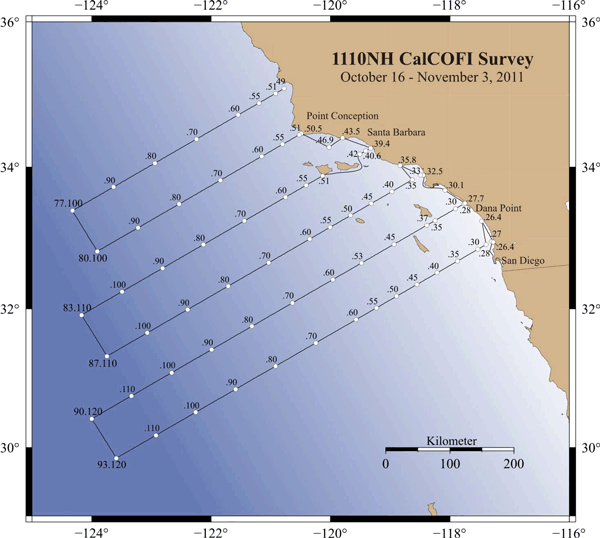UNITED STATES DEPARTMENT OF COMMERCE
National Oceanic and Atmospheric Administration
NATIONAL MARINE FISHERIES SERVICE
SOUTHWEST FISHERIES SCIENCE CENTER
8604 La Jolla Shores Drive
LA JOLLA, CA 92037-1508
October 5, 2011 F/SWC1:AEH
NOAA CRUISE ANNOUNCEMENT (pdf version)
VESSEL: R/V New Horizon (SIO) Cruise 1110-NH.
CRUISE DATES: October 16 – November 3, 2011.
PROJECT: CalCOFI Survey, Fisheries Resources Division.
ITINERARY: Depart San Diego, California at 0800 on October 16, 2011.
Proceed to first CalCOFI station 93.3/26.7 (position 32.57.4'N/117.18.3'W) and begin a standard CalCOFI pattern (see attached cruise track). The vessel will return to San Diego, California on November 3, 2011.
OBJECTIVES:
- To continue an ongoing assessment of pelagic fish stocks between Morro Bay and La Jolla, California.
- To monitor environmental conditions within the CalCOFI survey area.
- To conduct continuous underway sampling of surface waters. Temperature, salinity and chlorophyll will be automatically logged by computer with the output from the GPS navigational unit.
- To record current profiles throughout the duration of the cruise with the Acoustic Doppler Current Profiler.
- To measure optical profiles within the California bight. The optical profile measurements will include pigment concentration and particle absorption.
- To record continuous acoustic targets obtained with the Simrad EK-60 scientific sounder.
PROCEDURES: 1. Each standard CalCOFI station will include the following:
- A CTD/Rosette consisting of 24 10-liter hydrographic bottles will be lowered to 500 meters (depth permitting) to measure physical parameters and collect water at discrete depths for analysis of: oxygen concentration, salinity, nutrients, chlorophylls and phytoplankton.
- A CalBOBL (CalCOFI Bongo) standard oblique plankton tow with 300 meters of wire out, depth permitting, using paired 505 µm mesh nets with 71 cm diameter openings. The technical requirements for this tow are: Descent rate of 50 meters per minute, ascent rate of 20 meters per minute. All tows with ascending wire angles lower than 38deg or higher than 51deg in the final 100 meters of wire will be repeated. Additionally, a 45deg wire angle should be closely maintained during the ascent and descent of the net frame.
- A Manta net (surface) tow, using a 505 µm mesh net on a frame with a mouth area of 0.1333 m².
- Weather observations.
- A Pairovet (vertical) plankton tow will be taken at all stations inshore of, and including station 70. The Pairovet net will be fished from 70 meters to the surface (depth permitting) using paired 25 cm diameter 150 µm mesh nets. The technical requirements for Pairovet tows are: Descent rate of 70 meters per minute, ascent rate of 70 meters per minute. All tows with wire angles exceeding 15deg during the ascent will be repeated.
- A PRPOOS(Planktonic Rate Processes in Oligotrophic Ocean Systems) net tow will be taken at all stations on line 90.0 and 80.0 as well as stations out to and including station 70.0 on lines 86.7 and 83.3. These stations are occupied as part of the LTER(Long Term Ecological Reserve) project. The mesh of the PRPOOS net is 202 µm and the tow is a vertical cast up from 210 meters.
- At about 1100 hours on each day of the cruise a primary productivity CTD cast consisting of six 10-liter hydrographic bottles will be carried out. The cast arrangement will be determined by a Secchi disc observation. The purpose of the cast is to collect water from 6 discrete depths for daily in situ productivity experiments. Measurements of extracted chlorophyll and phaeophytin will be obtained with a fluorometer. Primary production to be measured as C14 uptake in a 6 hour in situ incubation. Nutrients will be measured with an auto-analyzer. All radioisotope work areas will be given a wipe test before the departure of the SIO technical staff.
- A light meter(secchi) will be used to measure the light intensity in the euphotic zone once a day with the primary productivity cast.
- During transit between stations, a bird observer and three mammal observers will be recording location and species of various sea birds and marine mammals.
- During transit between most daylight stations, an acoustic hydrophone array will be towed off the stern with a cable/winch to record sounds from marine mammals. Upon approaching a station, a sonobuoy will be deployed one nautical mile prior to stopping for station work.
- A MOHT(Oozeki) pelagic trawl will be deployed on approximately 20 night time CalCOFI stations within the standard CalCOFI grid(lines 76.7 to 93.3). This will encompass both adaptive and non-adaptive sampling in conjunction with the EK-60. The Oozeki is a fixed-frame trawl with a 5.5 m² mouth opening that can be towed at speeds up to 4-5 knots. It is designed to capture a variety of organisms including krill, late larval and juvenile fishes, and micronekton. The Oozeki data will be used to groundtruth the EK-60 acoustic data as well as collect samples of juvenile fishes for the study of sardine recruitment processes.

